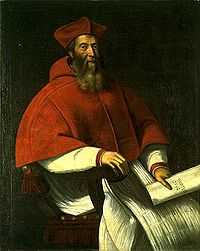Jacopo Sadoleto

Jacopo Sadoleto (July 12, 1477 – October 18, 1547) was Catholic Bishop and Cardinal, loyal to the Catholic Church.
Life
He was born at Modena in 1477, the son of a noted jurist, he acquired reputation as a neo-Latin poet, his best-known piece being one on the group of Laocoön. In Rome, he obtained the patronage of Cardinal Carafa and adopted the ecclesiastical career. Pope Leo X chose him as his secretary along with Pietro Bembo, and in 1517 made him bishop of Carpentras.
A faithful servant of the papacy in many negotiations under successive popes, especially as a peacemaker, his major aim was to win back the Protestants by peaceful persuasion and by putting Catholic doctrine in a conciliatory form. Sadoleto was a diligent bishop, made cardinal in 1536, given the titular church of San Callisto.[1]
In 1539 Cardinal Sadoleto wrote to the people of Geneva, urging them to return to the Catholic faith. John Calvin had been asked to leave Geneva the previous year, and was living in Strasbourg, but the Genevans still asked Calvin to write a response to Sadoleto, which he did.[2]
Sadolato died in Rome, aged 80.
See also
- Pericaud, Fragments biographiques sur Jacob Sadolet (Lyon, 1849)
- Joty, Etude sur Sadolet (Caen, 1857)
- Petrus Balan, Monumenta Reformationis Lutheranae, vol. i (Innsbruck, 1885)
- Rochini's edition of the letters (Modena, 1872)
References
His chief work, a Commentary on Romans, meant as a prophylactic against the new doctrines, gave great offence at Rome and Paris.
His collected works appeared at Mainz in 1607, and include, besides his theologico-ironical pieces, a collection of Epistles, a treatise on education (first published in 1533), and the Phaedrus, a defence of philosophy, written in 1538. The best collection is that published at Verona (1737–1738); it includes the life by Fiordibello.
 This article incorporates text from a publication now in the public domain: Chisholm, Hugh, ed. (1911). Encyclopædia Britannica (11th ed.). Cambridge University Press
This article incorporates text from a publication now in the public domain: Chisholm, Hugh, ed. (1911). Encyclopædia Britannica (11th ed.). Cambridge University Press
External links
- ↑ Cardinal Title S. Callisto GCatholic.org
- ↑ Both letters can be found in Calvin's Tracts Relating to the Reformation, translated by H. Beveridge, 1844. Digitized by Google Books.
|